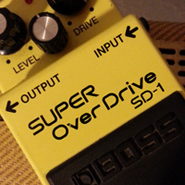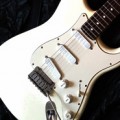The Boss SD-1 Super Overdrive is my Overdrive Pedal recommendation for beginners. I love this pedal because it gives you ‘rock’ at the flick of a switch. It really evokes that 80’s classic rock sound – think of any band who play with a wall of Marshall amps behind them. If I wanted a sound in the style of Guns ‘n’ Roses, Bon Jovi, Def Leppard, Van Halen, Whitesnake, Black Sabbath, The Cult, etc. then this is what I’d go for.
Likewise, if I just want some chunky power chords or heavy riffs, this would be my go to option. If a session or a musical calls for ‘drive’ in the score then this is what I switch on. If you’re more into metal then you might prefer next week’s distortion pedal suggestion as your default ‘heavy’ sound, but for me rock is where I’m most comfortable and this pedal does the job.
– It’s really cheap!
The best thing about this pedal is that it’s really cheap. You can get it for £ 39 new and you can usually pick one up second hand on eBay for around £25 including postage if you’re prepared to wait for the right auction to come up. There’s really no reason not to own one!
– Gain up for classic rock, lower for 70’s rock
The controls on the Super Overdrive are pretty straightforward. Level sets the overall volume coming out of the pedal. Gain sets the amount of overdrive. Turning the gain up past 12 o’clock gets you into 80s rock territory for thick, chunky chords and lead tones. Below 12 o’clock you will get a lighter drive.
This pedal never quite goes down to what I’d call crunch, but reducing the gain will clean the sound up a bit and allow more of the natural dynamics of your playing to come through. I’d use this for Led Zeppelin, AC/DC, Black Sabbath type sounds. I feel the drive on this pedal starts where the Blues Driver leaves off.
– Tone control for clearer lead versus slushy Sabbath sound
The tone control on the SD-1 is very useful. Effectively it reduces the treble on the sound coming out of the pedal. If you turn it all the way up you will get a very bright, shrill sound, which can be quite harsh. All the way down and you get a sludgy, mushy, indistinct tone with no articulation. I usually start with the tone control at 12 o’clock and then tweak it one way or the other.
For a rhythm sound in a band with lots of instruments I would probably turn the tone a little bit above 12 o’clock to give my sound some presence but keep the overall level low. In a smaller band I might keep the tone around 12 o’clock for a bigger, more powerful sound. If I wanted a slushy, doom laden Black Sabbath type tone I’d turn the tone right down.
For lead sounds I’d turn the tone up for searing 80’s rock solos – Van Halen, Def Leppard, etc. For a bluesier feel I’d back the tone off and boost the volume a bit for a thicker sound.
As you can see there are plenty of possibilities even with just the three controls.
– Famous users – Van Halen, Zakk Wylde, Billy Duffy, Jonny Greenwood, Robert Smith
As far as famous users go, lots of great players have used this pedal in the past, although I’m not aware of too many who still use it these days. The only one I’ve come across recently is Hard Rock session legend John 5.
There are hundreds of pedals out there competing for this kind of sound. Most professionals will usually have a selection and the Super Overdrive has usually made way for more expensive options on their pedal boards. However, I still think it’s a great place to start for beginners.
Guitarists who’ve used it in the past include Eddie Van Halen (Van Halen), Zakk Wylde (Ozzy Osbourne), Billy Duffy (The Cult), Jonny Greenwood (Radiohead) and Robert Smith (The Cure).
– Sounds
Here’s a demo of some of the sounds you can get out of the pedal. It’s recorded using a Yamaha Pacifica guitar through a Blackstar HT-5R amp on the clean channel. All the guitar sounds are going through the Super Overdrive. I used different pickups, volume setting on the guitar and the settings on the pedal to get the different sounds. This is by no means an exhaustive presentation of the SD-1’s possibilities, but it gives you an idea of what it can do.
– Summary
Overall, this pedal is a good place to start to get you rocking out like the guitar legends of yesteryear. If rock is your thing then eventually you will want to experiment with other overdrive pedals and explore all the different subtleties and nuances they can bring. But until then, the Super Overdrive will capture the vibe nicely, all for less than the cost of a couple of cinema tickets.
What’s your favourite overdrive pedal? Let me know in the comments below






This pedal is the pedal that i am using, it is really awesome
Hi, a simple question. If you are using a Blackstar HT5R to demonstrate sound, why not just use the footswitchable gain on the amp? Just curious.
Hi Cal, that’s a good question, the overdrive built in to the Blackstar HT5R is excellent – probably better than the SD-1 to be honest. However, this blog was specifically about the SD-1 pedal so it made sense to do the demo with that!
Also, as this post is aimed at beginners, they may not have an amp with overdrive as good as the Blackstar. In that case the SD-1 would be a really good option. Some entry level amps have terrible built-in overdrive. In these cases the Super Overdrive is a great, cheap way to get a good overdrive sound.
Lastly, sometimes you may want to put other effects after the overdrive (chorus, delay, reverb, etc). If you’re getting the overdrive from the amp that’s more difficult. Of course you can use the effects loop but this post was aimed at beginners and that might be a bit involved at the early stages.
In fact, even in professional work I often find it a pain to use the effects loop. It takes extra time to set up and involves running extra cables across the performance space between your pedal board and your amp. When time is precious at a session or rehearsal this can be hassle that you don’t need. So I prefer to set up an all purpose pedal board and use a clean amp when I need maximum speed and flexibility.
Amp overdrive is great – usually better than pedals or other effects if you have a quality amp. However, I generally only rely on it when it’s my own gig and I have the luxury of a decent time to set up and soundcheck. In other situations, a good pedal or three can be a lifesaver. For beginners who are still playing through entry level equipment pedals can offer great sounds without having to spend £250 plus on a good amp.
Cheers,
Matt
Thanks Matt. Appreciate your explanation. Keep up the good work. Cal